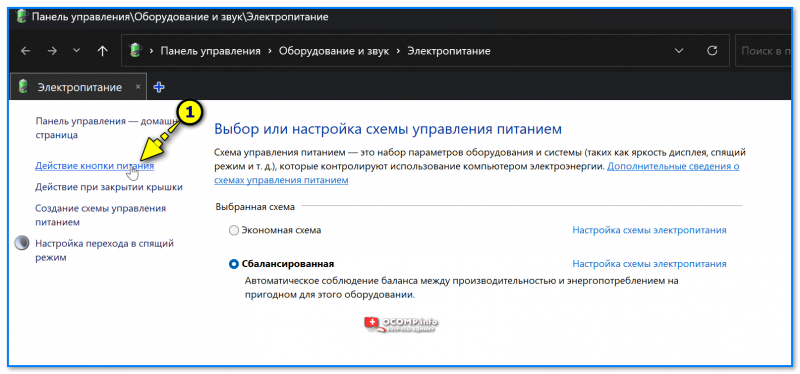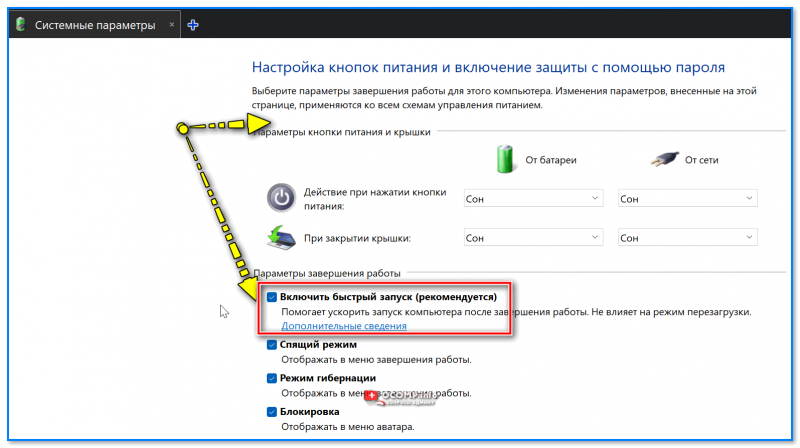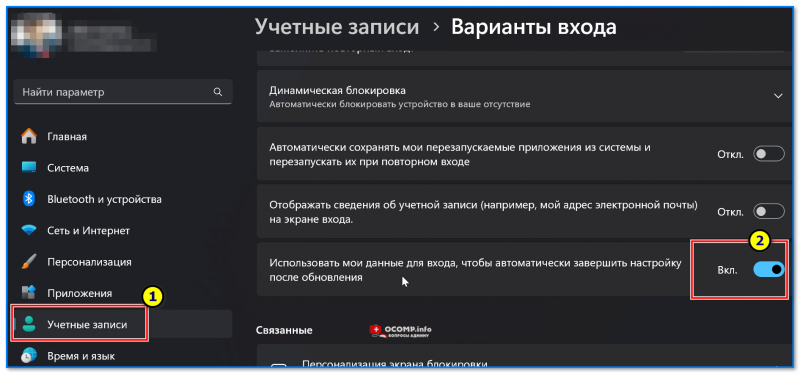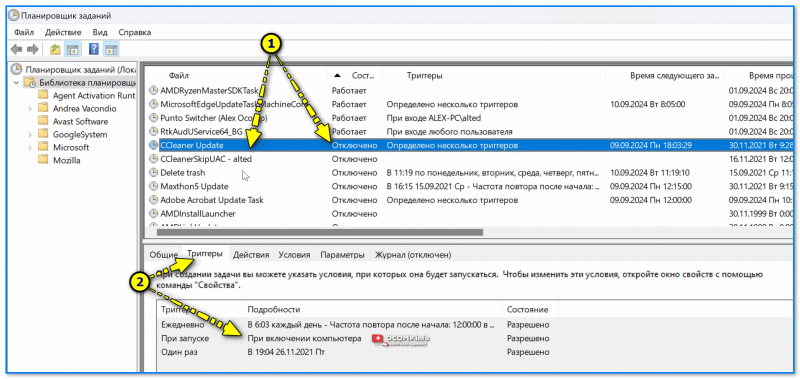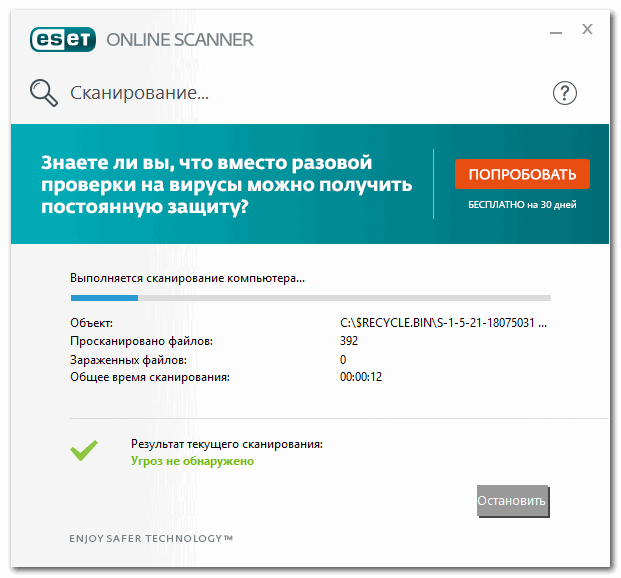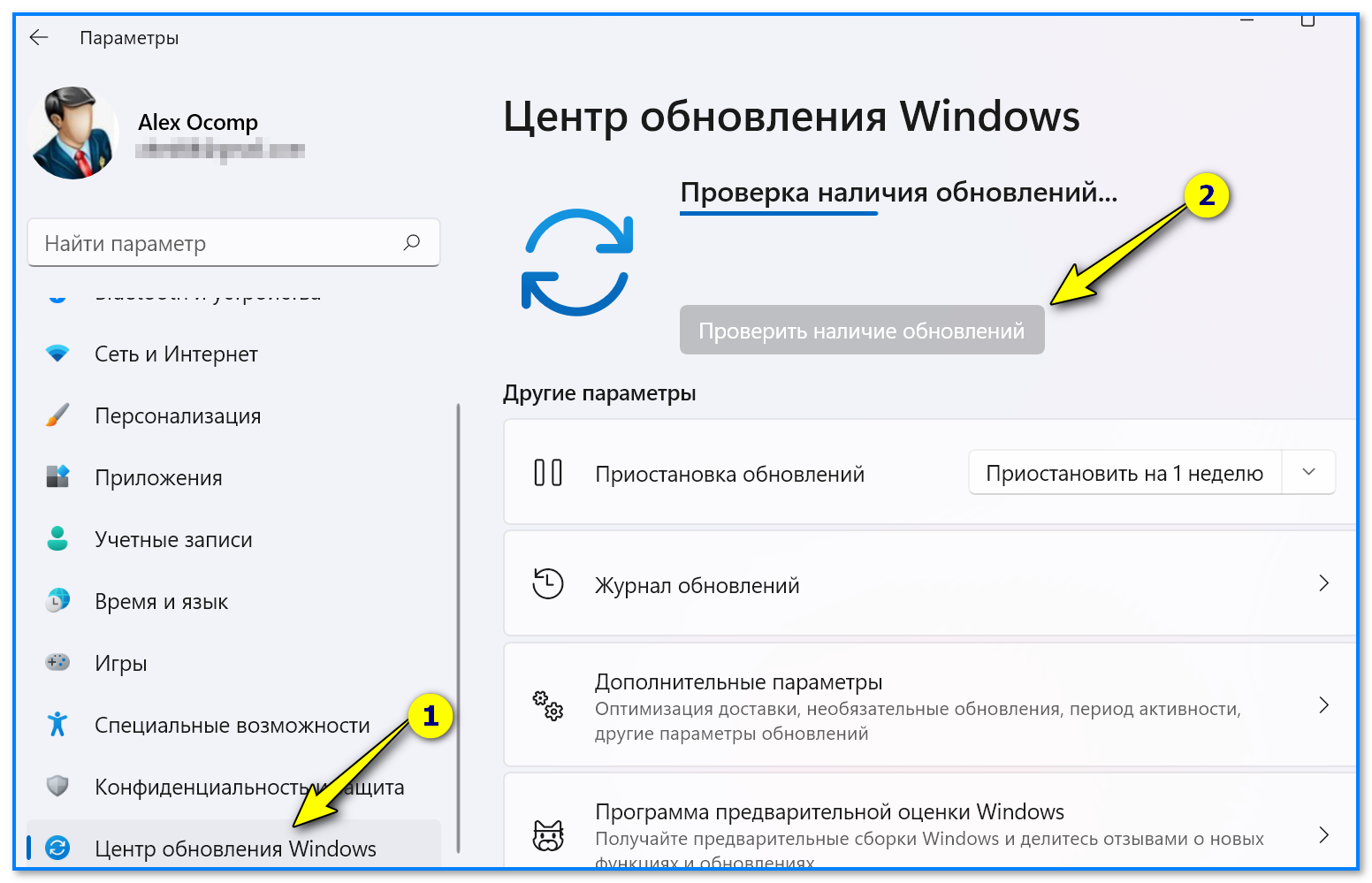Содержание статьи:
- Рекомендации по устранению
- Первое
- Второе
- Третье
- Четвертое (общие рекомендации)
- Вопросы и ответы: 0
Здравия!
Вероятно вы наткнулись на эту заметку из-за сообщения на экране про какой-то там «Task Host Windows»*, который мешает выкл. компьютер?! (см. пример на рис. ниже)
* Для начала отвечу о том, что это вообще такое «Task Host Windows»?
Это системное приложение Windows, отвечающее за работу с DLL библиотеками других программ. Работает оно постоянно, и если есть какое-то задание (даже отложенное, фоновое) — то при выкл. компьютера можно увидеть как раз это предупреждение о работе «Task Host Windows»… 👇
Т.е. в подавляющем большинстве случаев причина в появл. окна — какое-нибудь стороннее ПО, которое в данный момент работает (некоторые игры, редакторы, оптимизаторы, не сохраненные документы, и т.п.)
Ниже рассмотрим неск. рекомендаций, как его убрать (и что вообще можно сделать…). 😉👌
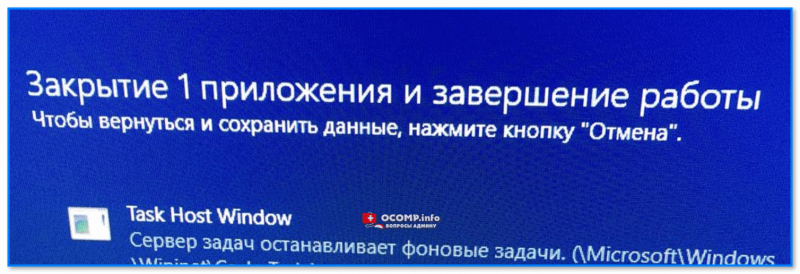
Task Host Windows. Закрытие одного приложения и перезагрузка — Чтобы вернуться и сохранить данные нажмите отмену. Сервер задач останавливает фоновые задачи // в качестве примера
*
Рекомендации по устранению
Первое
При появлении подобного окна (как на рис. ниже/выше) — обратите внимание на описание. Как правило, всегда указывается либо само «проблемное» приложение (например, Word или Блокнот 👇), либо фоновый процесс, который мешает завершить задачу.
Если данные из этого указанного приложения вам не нужны* — то можно просто-напросто нажать на кнопку «Все равно перезагрузить / выкл.» (как в примере ниже👇), и на этом вопрос должен быть решен…
*Разумеется, если данные из приложения нужны — необходимо отменить выключение ПК и предварительно всё сохранить на диск…
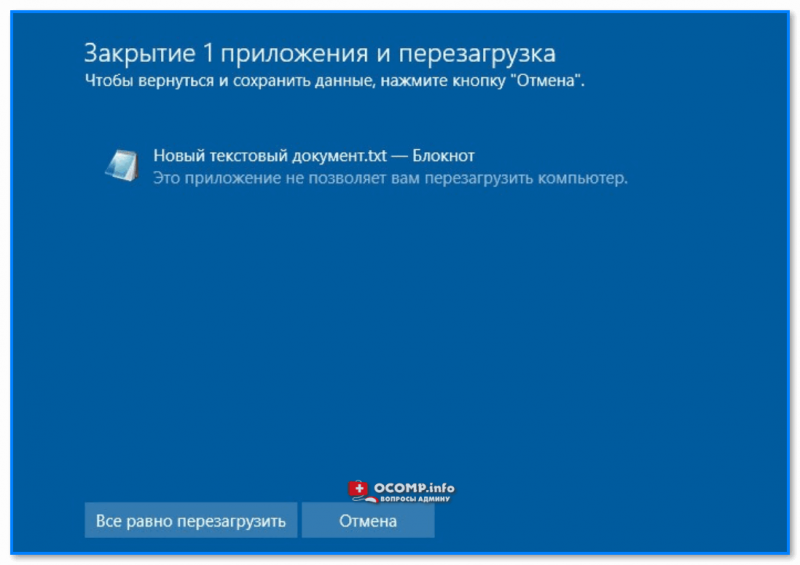
Проблема с блокнотом. Закрытие 1 приложения и перезагрузка… (еще один пример).
*
Второе
Если приложение из описания не очевидно (и вы не знаете из-за чего появляется окно с «Task Host Windows») — можно попробовать его узнать через 📌диспетчер задач (нажмите Ctrl+Alt+Del для его вызова).
Далее нужно открыть вкладку «Сведения» (либо «Подробности», зависит от версии Windows), найти процесс «taskhostw.exe», нажать по нему правой кнопкой мыши и перейти во вкладку «Анализ цепочки ожидания».
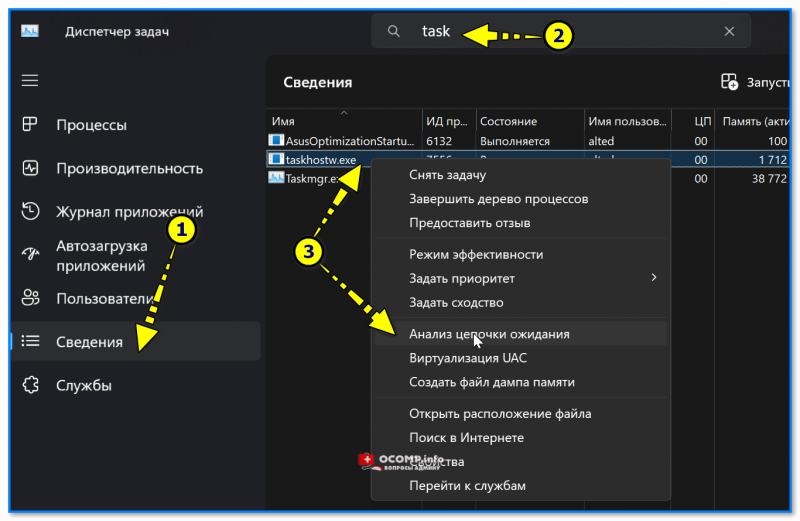
Анализ цепочки ожидания — Диспетчер задач Windows 11
Затем должно появиться окно с деревом процессов и приложений, которые вызывают «проблему»… 👇👌
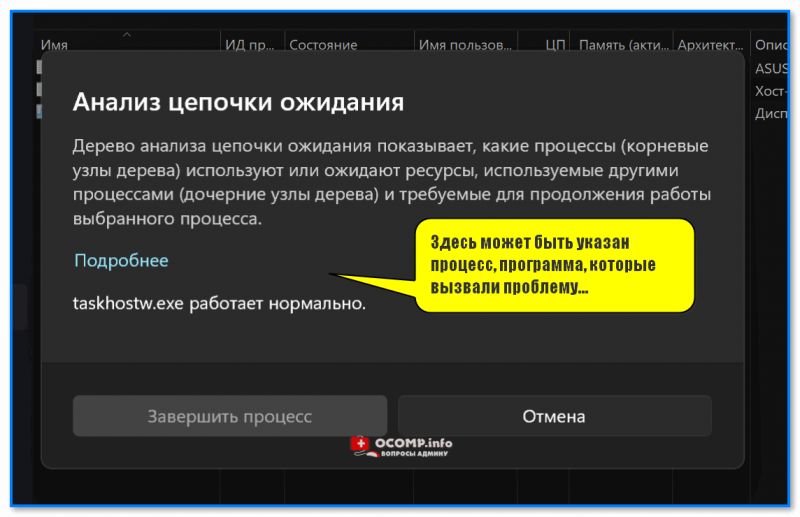
Здесь может быть указан процесс, программа, которые вызвали проблему…
*
Третье
Есть ряд параметров, которые могут приводить к рассматриваемой проблеме — и на время диагностики я бы порекомендовал вам попробовать их откл.:
- быстрый запуск: чтобы его откл. — необходимо открыть настройки электропитания (Win+R, и команда powercfg.cpl), затем перейти в «Действие кнопки питания» и снять галочку напротив пункта «Вкл. быстрый запуск» 👇👇(Перезагрузить ПК);
Действие кнопок питания
Откл. быстрый запуск — настройки электропитания Windows
- в параметрах Windows 10 (11) во вкладке «Учетные записи \ варианты входа» можно откл. использование данных для входа при заверш. настройки после перезапуска и обновлений (рекомендуется передвинуть ползунок в режим «Выкл.»);
Учетные записи — варианты входа — исп. мои данные — Windows 11
- также рекомендуется пройтись в «Планировщике задач» (Win+R, команда control schedtasks) по всем задачам, и поискать, какие из них работают в текущий момент + какие поставлены на активацию при выкл. компьютера. Затем всё незнакомое и ненужное откл.! Примечание: для откл. задачи — нажмите по ней ПКМ и выберите опцию «Откл.», чтобы у нее поменялось состояние (см. скрин ниже стрелка-1).
Отключаем регулярный запуск всего ненужного — планировщик заданий Windows
*
Четвертое (общие рекомендации)
- во-первых, стоило бы проверить свой компьютер антивирусом (это можно быстро сделать с помощью 📌онлайн-сканеров, которые не нужно устанавливать);
Работа сканера ESET’s Free Online Scanner
- во-вторых, не лишним было бы проверить обновления (при наличии оных — обновить Windows. 📌В помощь: как обновить Windows до посл. версии);
Центр обновления в Windows 11
- в-третьих, стоит проверить (и восстановить при необходимости) системные файлы в Windows. Как это сделать с помощью SFC, Chkdsk и DISM 📌показывал в этой заметке;
- в-четвертых, если все остальное не помогло — можно попробовать посмотреть 📌точки восстановления. Если среди них есть точка с датой создания при которой все работало штатно — можно попробовать 📌откатить систему к ней.
*
Дополнения и иные решения — приветствуются в комментариях (См. форму для комментирования ниже).
Всем удачи!
👋
How to Fix Task Host Window Preventing Shutdown
The Task Host Window issue that prevents your computer from shutting down can be incredibly frustrating. Users often encounter a message that indicates applications are still running, even if all visible programs are closed. This article will provide a comprehensive guide on how to troubleshoot and resolve the Task Host Window obstacles when attempting to shut down your Windows computer.
Understanding the Task Host Window
Before diving into the fixes, it’s essential to understand what the Task Host Window is. The Task Host Window is a part of the Windows operating system that manages processes running in the background. It ensures that applications are properly closed before the system proceeds with shutdown or restart.
Typically, users may notice a pop-up that states, «The Task Host Window is preventing Windows from shutting down.» This generally means that some background applications or processes need to be closed first. Here are several reasons why the Task Host Window can interfere with shutdown:
- Unfinished application processes: Applications that do not close properly can linger in the background, prompting the Task Host Window.
- Pending Windows updates: Sometimes, system updates require certain applications to close before proceeding with shutdown.
- Background services: Certain services or processes might still be running without user knowledge.
Common Symptoms
The key symptom of the Task Host Window issue is the inability to shut down or restart your computer without seeing the Task Host Window pop-up. Other symptoms may include:
- Slow performance when trying to shut down or restart.
- A particular application that remains stuck in a closing state.
- Unresponsive applications that can’t be forcibly closed through normal methods.
Basic Troubleshooting Steps
Before delving into more advanced solutions, it’s wise to try some basic troubleshooting steps:
1. Wait It Out
Sometimes, simply waiting a few moments allows the operating system to finish its tasks. Certain applications may take longer than anticipated to close. If waiting doesn’t resolve the issue, proceed to further steps.
2. Close Applications Manually
Firstly, ensure all visible applications are closed. This includes minimizing any open applications and using the task manager to close down anything that might be running:
- Press
Ctrl + Shift + Escto open Task Manager. - Look for any applications that are still open and select them.
- Click on «End Task» to close any applications that might be running.
3. Restart Your Computer
If all else fails, restarting your computer can often resolve minor glitches. It refreshes system processes and terminates any residual tasks. After a restart, attempt to shut down once more.
Advanced Solutions to Fix Task Host Window
If the basic troubleshooting didn’t help, several advanced solutions can be employed to address the issue of the Task Host Window preventing shutdown:
1. Identify Stubborn Processes
Using Task Manager
Repeatedly closing applications can be tedious. To identify which process is causing the Task Host Window to appear:
- Open Task Manager with
Ctrl + Shift + Esc. - Click the «Details» tab to see a complete list of running processes.
- Look for any processes that might correspond to applications that are no longer visible or have become unresponsive.
Using Command Prompt
Another way to find lingering processes is via Command Prompt:
- Press
Win + R, typecmd, and hit Enter. - Enter the command
tasklist. - This will display all running processes. Identify any you don’t recognize or that may relate to applications you’ve previously used.
2. Update Windows
Keeping Windows updated can sometimes solve underlying issues that lead to the Task Host Window:
- Press
Win + Ito open Settings. - Navigate to
Update & Security. - Click on
Check for updates. - Install any available updates and restart your device.
3. Disable Background Apps
Some applications are set to run in the background, which can lead to the Task Host Window preventing shutdown. To disable these:
- Go to
Settings>Privacy. - Scroll down to
Background apps. - Toggle off apps that you do not need running in the background.
4. Check for Pending Updates or Restarts
Sometimes Windows updates do not complete fully or require a restart that hasn’t been processed. To ensure everything runs smoothly:
- Check for pending updates by going to
Settings>Update & Security. - Install pending updates and restart your computer.
5. Disable Fast Startup
The Fast Startup feature can lead to unstable shutdowns and startup behavior in Windows. Disabling it can help reduce the chances of encountering the Task Host Window issue:
- Open
Control Panel. - Go to
Hardware and Soundand thenPower Options. - Click on
Choose what the power button does. - Click on
Change settings that are currently unavailable. - Uncheck the box for
Turn on fast startupand save changes.
6. Run System File Checker (SFC)
Corrupted system files can trigger various issues, including those associated with the Task Host Window. The System File Checker scans for and repairs corrupted files:
- Open Command Prompt as an administrator: Press
Win + Xand selectCommand Prompt (Admin). - Type
sfc /scannowand press Enter. - Wait for the process to complete and follow any prompts to fix issues.
7. Perform a Clean Boot
A clean boot allows you to start Windows with minimal drivers and programs, helping to pinpoint issues:
- Press
Win + R, typemsconfig, and hit Enter. - In the
System Configuration, go to theServicestab. - Check the box for
Hide all Microsoft servicesand clickDisable all. - Go to the
Startuptab and clickOpen Task Manager. - Disable all startup items.
- Restart your computer and check if the issue persists.
8. End Task Host Process
As the Task Host Window displays when applications fail to close, directly terminating its process may sometimes help:
- Open Task Manager.
- In the
Processestab, look forTask Host. - Right-click and select
End Task. - Attempt to shut down your computer again.
9. Check for Malware
Malware infection can cause various problems, including interference with normal shutdown processes. Regular scanning can help:
- Install and run trusted antivirus software such as Windows Defender.
- Perform a full scan and deal with any detected threats.
10. Restore or Reset Windows
If all else fails, you might consider restoring to an earlier point or resetting Windows entirely:
System Restore
You can revert your system to a point before the issue occurred:
- Open the Control Panel.
- Go to
Recoveryand thenOpen System Restore. - Follow the prompts to restore your computer to an earlier state.
Reset Windows
If nothing else works, resetting Windows may be your last resort. Remember to back up important files first:
- Go to
Settings>Update & Security>Recovery. - Under
Reset this PC, clickGet startedand follow the onscreen instructions.
Additional Tips for Maintaining System Stability
To avoid encountering the Task Host Window issue in the future, here are some best practices:
- Keep Software Updated: Regularly check for updates for all installed applications.
- Manage Startup Programs: Control which applications are allowed to start on boot-up to reduce the possibility of background process interference.
- Use Trusted Software: Avoid unsupported or poorly-rated programs that may conflict with system processes.
- Regular Maintenance: Regularly clean up your computer, removing any unnecessary files or applications.
- Backup Your System: Ensure you have recent backups to prevent data loss during troubleshooting.
Conclusion
The Task Host Window preventing shutdown can be a vexing issue, reminiscent of the more intricate aspects of Windows systems. By systematically troubleshooting, users can often identify and resolve the underlying causes for this problem. From simple tasks like manually closing applications to more complex actions such as running System File Checker or resetting Windows, various techniques can restore functionality.
By incorporating regular maintenance and being proactive in managing software, users can minimize the chances of such disruptions in their future computing experience. If the problem persists, consulting with a professional technician may be beneficial for deeper system diagnostics.
Certainly! Below is a detailed article about «How to Fix Task Host Window Preventing Shutdown.»
How to Fix Task Host Window Preventing Shutdown
The Windows operating system is renowned for its user-friendly interface and functionality, but like any technology, it isn’t devoid of glitches. Among these glitches, users often encounter the «Task Host Window Preventing Shutdown» error message. This issue can be frustrating, particularly when you need to power down your device quickly. In this comprehensive guide, we will explore the Task Host Window, what triggers this problem, and elaborate on various solutions to fix it effectively.
Understanding Task Host Window
Before diving into how to resolve the «Task Host Window Preventing Shutdown» error, it’s crucial to understand what the Task Host Window is. Essentially, Task Host serves as a mediator for executing tasks that require closing applications or performing background tasks. It plays a vital role in ensuring that shutdown operations are carried out smoothly without corrupting any data or interrupting processes abruptly.
However, when the Task Host encounters issues, such as a background application preventing it from completing its task, users may receive a notification indicating that it is preventing the system from shutting down. This results in an interface where the user is forced to take action before the shutdown can proceed.
Common Causes of the Task Host Window Error
Several factors can lead to the Task Host Window preventing a shutdown. Some of the most prevalent causes include:
-
Running Applications: When an application remains open, especially those that require background processing or updating, the Task Host Window will prevent shutdown to save your work and ensure the applications close properly.
-
Pending Windows Updates: Windows often requires a restart to complete the installation of updates. If the updates are not finalized, the Task Host will prevent shutdown.
-
Faulty Drivers: Outdated or corrupt drivers can lead to conflicts that manifest as errors in the Task Host.
-
Corrupted System Files: Windows relies on various system files for operation. If any of these files are corrupted, the Task Host may struggle to manage applications effectively.
-
Malware or Virus Infection: Some malicious software can interfere with normal operations, causing shutdown errors.
Effects of the Task Host Window Issue
When this issue arises, users may experience various negative effects:
- Inconvenience: The inability to shut down the computer can significantly delay tasks, especially in critical situations.
- Data Loss: If users are forced to restart their machines without shutting down properly, they risk losing unsaved data.
- Increased Wear: Running a computer longer than necessary can lead to increased wear and tear on hardware components.
Step-by-Step Solutions to Fix the Task Host Window Error
To tackle the issue effectively, we’ll walk through various methods you can employ to rectify the Task Host Window preventing shutdown error.
Solution 1: Close Applications Manually
The simplest and most immediate solution is to ensure that all applications are closed before attempting to shut down your system.
- Check the taskbar for any open applications.
- Right-click on each application and select “Close” or simply click on the “X” icon.
- If there are applications that won’t close, you may use Task Manager:
- Press
Ctrl + Shift + Escto open Task Manager. - Under the “Processes” tab, locate any running applications, select them, and click on “End Task.”
- Press
Once you’ve ensured all applications are closed, try shutting down your computer again.
Solution 2: Complete Pending Windows Updates
Sometimes, pending updates can cause the Task Host to hang during shutdown. To check for updates:
- Go to Settings > Update & Security > Windows Update.
- Click on “Check for updates.”
- If updates are available, allow them to download and install, following all prompts.
- After installation, restart your system to ensure the updates are fully applied.
Solution 3: Disable Fast Startup
Fast Startup is a feature in Windows that can sometimes lead to issues with the Task Host. Disabling this feature might help:
- Open the Control Panel and navigate to Power Options.
- Click on “Choose what the power buttons do.”
- Click on “Change settings that are currently unavailable.”
- Scroll down to the “Shutdown settings” section and uncheck “Turn on fast startup (recommended).”
- Click “Save changes” and try shutting down your computer.
Solution 4: Scan for Corrupted System Files
Corrupted system files can cause applications to hang unnecessarily, which may trigger the Task Host Window warning. To run a system file scan:
- Open the Command Prompt as Administrator:
- Search for “cmd” in the start menu, right-click, and select “Run as administrator.”
- Type the following command and press Enter:
sfc /scannow - The System File Checker will scan for corrupt files and attempt to repair them automatically.
- Once the process completes, reboot your computer to check if the issue persists.
Solution 5: Update Device Drivers
Outdated or corrupted drivers might cause issues with Task Host Window. Here’s how to update your drivers:
- Right-click on the Start menu and select “Device Manager.”
- Expand the categories and right-click on any device, selecting “Update driver.”
- Choose “Search automatically for updated driver software” and follow any prompts.
- Repeat this for critical drivers, especially Graphics, Network, and Storage controllers.
- After the updates, restart your computer.
Solution 6: Perform a Malware Scan
Infections may disrupt normal functioning, including the operation of the Task Host Window. Use Windows Defender or any trusted antivirus software to perform a comprehensive scan:
- Open Settings > Update & Security > Windows Security.
- Click on “Virus & threat protection.”
- Click on “Quick scan” or select “Scan options” for a full scan.
- Follow the prompts to remove any found threats, then restart your computer.
Solution 7: Investigate Startup Programs
Sometimes, specific applications set to run at startup may prevent shutdown. To disable unnecessary startup programs:
- Press
Ctrl + Shift + Escto open Task Manager. - Go to the “Startup” tab.
- Right-click on any unnecessary applications and select “Disable.”
- Restart your computer, then attempt to shut down again.
Solution 8: Safe Mode Troubleshooting
Starting your computer in Safe Mode can help determine if the installed applications are responsible for the error. Here’s how:
- Press
Windows + Rand typemsconfig, then hit Enter. - In the System Configuration window, go to the “Boot” tab.
- Check “Safe boot” and select the “Minimal” option.
- Click “OK” and restart your computer. Your PC will now boot in Safe Mode.
- Try shutting down. If it works, this may indicate a software issue.
To exit Safe Mode, repeat the process but uncheck “Safe boot.”
Solution 9: Clean Boot
A clean boot will start Windows with a minimal set of drivers and startup programs, which can help isolate the cause of the Task Host Window issue:
- Type
msconfigin the Run dialog box (pressWindows + Rto open Run). - In the System Configuration window, navigate to the “Services” tab.
- Check the box for “Hide all Microsoft services,” then click “Disable all.”
- Go to the “Startup” tab and click “Open Task Manager.”
- In Task Manager, disable all startup items.
- Close Task Manager and click “OK” in the System Configuration window.
- Restart your computer and check if the problem persists.
Solution 10: Reset Windows
As a last resort, if you’ve exhausted all other options and none work, consider resetting your Windows installation. This operation will either keep your files or remove everything.
- Go to Settings > Update & Security > Recovery.
- Under “Reset this PC,” click on “Get started.”
- Choose either “Keep my files” or “Remove everything,” based on your preference.
- Follow the prompts to reset Windows.
Note: Make sure to back up your data to avoid unintentional data loss.
Conclusion
The “Task Host Window Preventing Shutdown” issue can be an annoying roadblock for many Windows users, but it is generally fixable with some troubleshooting steps. Whether it’s closing applications, updating software, or scanning for malware, various methods exist to tackle the predicament effectively. By systematically following the solutions outlined in this guide, you can resolve the error and enjoy a smoother computing experience.
Remember, maintaining your system regularly through updates and cautious software use can prevent such issues from arising in the future. Should the problem persist even after attempting these remedies, consider seeking professional assistance or guidance from technical support to address underlying problems with your system’s health.
The above content covers the topic in detail, providing explanations, potential causes, effects, and a variety of solutions to fix the Task Host Window preventing shutdown issue. If you require more information or additional sections, feel free to ask!
Download Article
Get rid of the Task Host window on shutdown
Download Article
- Troubleshooting Task Host Window
- What is Windows Task Host?
- What is the Task Host error?
- Video
|
|
|
Are you seeing the Task Host window when trying to shut down your computer? This window may pop up for a brief second, and it may be alarming if you’re unsure what it is. Luckily, this is an official Windows program, so it isn’t a virus. If you’re annoyed by the pop-up while trying to shut off your PC, we’ll show you how to fix it. Here’s what to do about the Task Host window preventing shutdown on Windows 11 and Windows 10.
How to Stop Windows Task Host Error
If the Windows Task Host is preventing shutdown, it’s likely due to a recent update. However, you should scan your computer for viruses, run the Windows Troubleshooter, and run the System File Checker to rule out software issues. The Task Host window will only appear for a second and is usually harmless.
-
While the Windows Task Host isn’t a virus or malware, you’ll want to make sure you don’t have any other malicious programs on your device.
- You can use a third-party antivirus program, or you can run the built-in scanner in Windows Security.
-
This built-in tool helps you find errors on your device. It’ll show you recommended troubleshooting steps if it finds an issue.[1]
To launch the tool, do the following:- Click the Start menu and type «troubleshoot settings».
- Click Troubleshoot settings.
- Click Additional troubleshooters.
- Click an option and click Run the troubleshooter.
- Repeat for all options.
Advertisement
-
This option may be causing the Task Host window to appear when you’re trying to shut down your computer. To disable it, do the following:
- Click the Start menu and type «control panel».
- Click Control Panel.
- Click Power Options.
- Click Choose what the power buttons do in the left panel.
- Click Change settings that are currently unavailable at the top.
- Uncheck the box for Turn on fast startup.
- Restart your computer.
-
When you try to turn off your computer with apps running in the background, you’ll get a pop-up prompt from Windows notifying you. If you proceed, Windows will force-shutdown the apps. To prevent this window, make sure all apps are closed. You can check by doing the following:
- Right-click the taskbar.
- Click Task manager.
- Select an open program.
- Click End task.
-
If you don’t have any apps running in the background when you shut down Windows, you may have an update scheduled for later. To check any awaiting updates, do the following:
- Click the Start menu and type «check for updates».
- Click Check for updates.
- Click Check for updates again.
- If needed, click Change active hours to update at a different time, or Pause updates to update it manually on your own time.
-
This built-in command scans your computer for corrupted files. To use it, do the following:
- Open the Command Prompt as an administrator.
- Type sfc /scannow and press Enter.
- Type Dism /Online /Cleanup-Image /CheckHealth and press Enter.
- Type Dism /Online /Cleanup-Image /ScanHealth and press Enter.
- Type DISM /Online /Cleanup-Image /RestoreHealth and press Enter.
- Restart your computer.
-
A clean boot starts Windows up with minimal drivers and programs. This helps you determine if another app is affecting your computer’s performance. This is only recommended if you’re familiar with advanced boot options.[2]
Do the following:- Make sure you’re on the administrator account.
- Click the Start menu and type msconfig.
- Click System Configuration.
- Click the Services tab.
- Check the box for Hide all Microsoft services.
- Click Disable all.
- Click Apply.
- Click the Startup tab and click Open Task Manager.
- Select a program that has the Enabled status.
- Click Disable.
- Close the Task Manager.
- In System Configuration, click OK.
- Restart your computer to look for errors.
- To enable it again, open System Configuration and select Normal Startup. Select the Services tab, uncheck the box for Hide all Microsoft services, click Enable all, and then click Apply. Enable all disabled programs in the Task Manager. Then, restart your computer.
-
The Task Host window error has appeared for most users after a certain Windows update. Since it’s not recommended to revert updates (as these contain important security fixes), you may need to wait for Microsoft to release a new update that fixes this issue.
- Windows 10 support will end in October 2025. If you want to continue receiving new updates, you’ll need to upgrade to Windows 11.
Advertisement
-
If you’re worried about viruses or malware, don’t worry. The Task Host itself is a built-in program. However, if you have other unknown programs popping up, be sure to run an antivirus scan to rule out any harmful applications.
-
This window may pop up for only a second before the computer shuts down, raising concerns from some users. However, the Task Host is a Windows program, so you shouldn’t be too worried about viruses. Many users reported seeing this error after installing a new update.
Advertisement
Ask a Question
200 characters left
Include your email address to get a message when this question is answered.
Submit
Advertisement
Video
Thanks for submitting a tip for review!
References
About This Article
Thanks to all authors for creating a page that has been read 2,999 times.
Is this article up to date?
Содержание:
- 1 Что такое Task Host Windows и какую роль играет в системе
- 2 Как быть, если Task Host Windows не дает выключить компьютер
- 3 Отключение автоматического обслуживания
- 4 Уменьшение времени ожидания закрытия приложений
- 5 Второстепенные службы
- 6 Связанное задание
- 7 Дополнительные меры
Обычно выключение компьютера с Windows занимает совсем немного времени, однако в некоторых случаях система упорно не желает завершать свою работу, ссылаясь на некие незавершенные процессы. Процессы же эти могут быть как пользовательскими, так и системными. В первом случае достаточно просто вернуться в систему и закрыть мешающее завершению работы приложение или файл. Несколько иначе дела обстоят с системными процессами, принудительное завершение которых может вызвать сбой.
Помешать нормальному завершению работы Windows 7/10 способны разные процессы, но наиболее часто с нехорошей стороны себя проявляет Task Host Windows. Внешне это выглядит следующим образом. При выключении или перезагрузке компьютера на экране появляется сообщение «Task Host Window. Сервер задач останавливает фоновые задачи…».

Эта надпись может не исчезать довольно долго. Вины самого THW здесь нет, если только под него не маскируется вирус. Проблема же возникает чаще всего из-за использования процессом ресурсов фоновых или активных приложений, которые по какой-то причине остались незавершенными. Но обо всём по порядку.
Для начала вкратце о том, что это Task Host Windows и зачем он нужен. Источником процесса является системный файл taskhost.exe (в Windows 10 taskhostw.exe), расположенный в каталоге C:/Windows/System32 и отвечающий за корректную работу библиотек DLL различных приложений. Извлекая и запуская исполняемый код библиотек, он следит за их загрузкой, работой и выгрузкой из памяти. Если при завершении работы Windows какое-то приложение зависает, THW выводит на экран сообщение с именем проблемного приложения.

Замечая за файлом taskhost.exe повышенную активность, неопытные пользователи иногда пытаются удалить его, принимая за вирус, и тем самым совершают ошибку. Хотя этот файл не является критически важным для системы, его удаление способно привести к сбоям в работе приложений, в том числе и системных. Вероятность того, что вы имеете дело с маскирующимся под taskhost.exe вирусом, существует лишь тогда, когда файл обнаруживается в каталогах, отличных от C:/Windows/System32 или C:/Windows/WinSxS.
Как быть, если Task Host Windows не дает выключить компьютер
Если Task Host Window тормозит выключение компьютера с Windows 7/10 или другой версией системы, вы можете просто завершить работу процесса, нажав на экране кнопку «Все равно завершить» или «Все равно перезагрузить». Но при этом в дальнейшем не мешает проверить корректность работы того приложения, на которое указывает процесс. Чаще всего это приложения, работающие в Windows как службы, например, средства резервного копирования и автоматического обслуживания, монитор службы текстовой платформы, компоненты Windows Uрdаte и т.п.
В Windows 10 процесс THW нередко ссылается на приложение Device Install Reboot Required. Чтобы предотвратить торможение выключения ПК процессом Task Host Windows, в этом случае рекомендуется попробовать отключить использование пользовательских данных для входа в настройках системы. Открыв приложение «Параметры», перейдите в раздел Учетные записи – Параметры входа и отключите опцию «Использовать мои данные для входа для автоматического завершения…».

Если процесс THW указывает на MsCtfMonitor (монитор службы текстовой платформы), зайдите в Планировщик заданий, перейдите по цепочке Microsoft – Windows – TextServicesFramework и отключите задачу MsCtfMonitor. Правда, это может привести к тому, что у вас перестанет отображаться языковая панель, если это произойдет, включите задание.

Отключение автоматического обслуживания
Ошибка Task Host Windows при выключении компьютера Windows 10 может быть вызвана работой компонента, отвечающего за автоматическое обслуживание системы. Если он активен, отключите его, чтобы не мешал работе системы. Командой control откройте классическую Панель управления, запустите апплет «Центр безопасности и обслуживания», раскройте меню «Обслуживание» и нажмите ссылку «Остановить обслуживание».

Уменьшение времени ожидания закрытия приложений
Воспользовавшись несложным твиком реестра, вы можете уменьшить время ожидания остановки служб и завершения работы приложений при выключении/перезагрузке компьютера. Таким образом вы сократите время, в течение которого на экране будет отображаться сообщение процесса THW. Запустите командой regedit редактор реестра и разверните в правой колонке ветку HKEY_LOCAL_MACHINE/SYSTEM/CurrentControlSet/Control. Справа найдите строковый параметр WaitToKillServiceTimeout и измените его значение на меньшее, например, 2000 или 1000 миллисекунд.

Далее разверните ветку HKEY_CURRENT_USER/Control Panel/Desktop. В правой колонке создайте новый строковый параметр с именем WaitToKillServiceTimeout и установите в качестве его значения то же число, что и для одноименного параметра в разделе HKEY_LOCAL_MACHINE.


Сохраните настройки, перезагрузитесь и проверьте, не исчезла ли проблема с THW.
Второстепенные службы
Есть немало сторонних программ, которые устанавливают в Windows свои службы. Если они не являются для вас важными, деактивируйте их, так вы уменьшите общее время, требуемое на завершение работы операционной системы. Командой msconfig откройте утилиту «Конфигурация системы», переключитесь на вкладку «Службы», поставьте птичку в чекбоксе «Не отображать службы Windows», а затем нажмите «Отключить все».

Связанное задание
Если приведенные выше способы не помогли решить проблему, отключите в Планировщике заданий задачу RAC Task. Зайдите в Планировщик и в меню «Вид» установите галочку «Отобразить скрытые задачи».

Затем перейдите по пути Microsoft – Windows – RAC и отключите RAC Task.

Если подраздела RAC у вас нет, попробуйте отключить службу исполняемого файла, на который указывает процесс THW. Для этого в Диспетчере задач на вкладке «Подробности» кликните по процессу taskhost.exe (taskhostw.exe) ПКМ и выберите в меню «Анализ цепочки ожидания».

В открывшемся окошке появится процесс и его ID.

Жмем по процессу ПКМ и выбираем в меню «Перейти к службам». Определив службу, отключаем ее через оснастку управления службами. Но делаем это только в том случае, если она не является критически важной.
Дополнительные меры
В качестве других мер по борьбе с зависшим Task Host Window можно предпринять следующие действия:
- Проверить компьютер на предмет заражения вирусами.
- Запустить встроенное средство устранения неполадок «Питание».
- Удалить лишние элементы из автозагрузки.
- Проверить целостность системных файлов командой sfc /scannow.
- Создать новую учетную запись пользователя и работать из-под нее.
Радикальная мера – полная деактивация файла taskhost.exe – является самым крайним вариантом. Прибегнуть к нему можно только тогда, когда Task Host Windows вообще ни в какую не дает выключить компьютер. Для этого вам нужно будет загрузиться с любого LiveCD со встроенным файловым менеджером, перейти в расположение исполняемого файла taskhost.exe и переименовать его в taskhost.exe.bak.

Принятая мера должна решить все проблемы с Task Host Windows. Если вдруг после всех этих действий в системе возникнут неполадки, нужно будет опять загрузиться с «живого» диска и восстановить оригинальное имя файла taskhost.exe.
Подготовлено по материалам inetme.ru

Эксперт по ремонту и настройке ПК с более чем 5-летним опытом работы. Имеет профильное образование по специальности оператор ЭВМ.
Задать вопрос

